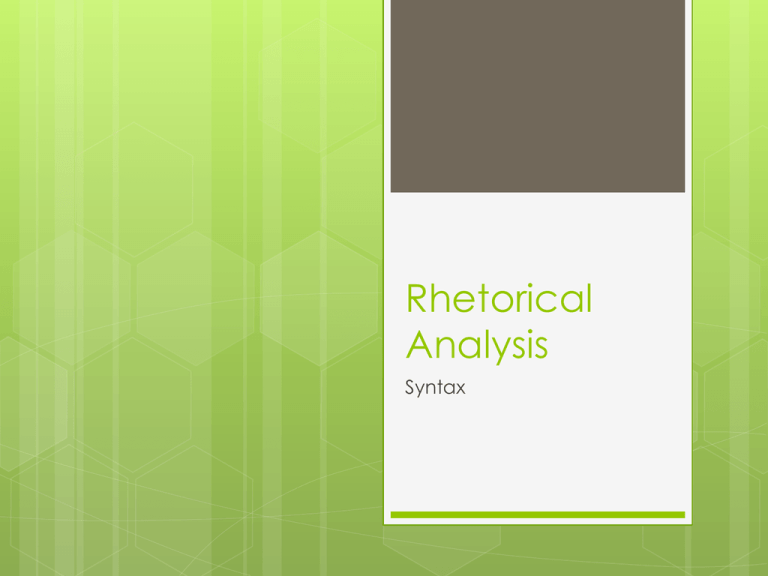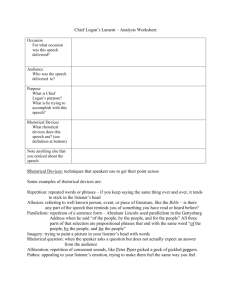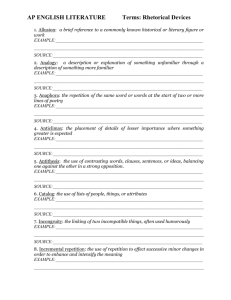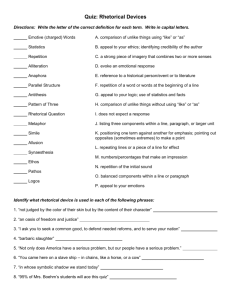Rhetorical Analysis
advertisement

Rhetorical Analysis Syntax How sentence structure may be a rhetorical strategy Syntax is the order of words in a sentence/the sentence structure Certain syntactical choices can have a rhetorical effect and can contribute to the rhetorical purpose. Parallelism A set of similarly structured words, phrases or clauses that appears in a sentence or paragraph; a grammatical pattern in clauses and sentences. prep. article noun “government prep. article of the people, by the people, and for the people” noun prep. art. noun Parallelism “Phrases and clauses that balance one another as each unit generates its own rhythm, until they coalesce into a unity that is all the more remarkable in its fusion of details that would otherwise have been rendered separately, like pieces unable to interlock because no one took the time to connect them. One of the great joys of reading authors like Henry James is seeing how they integrate ideas that are complementary, sometimes even antithetical, and provide them with a setting where they can be at home.” –explanation of parallelism in letter to editor, NYTIMES Book Review, Jan 12, 2011. Letter written by Bernard F. Dick Parallelism Dick’s idea of parallel structure as a home that unifies separate ideas can help us understand the rhetorical effects of parallel structure. When asked to explain the effects of parallelism, we follow steps: 1. Recognize the syntax: the repetition of grammatical patterns. Here we are finding the “home.” “government of the people, by the people, and for the people” 2. Identify the details that are fused, or brought together. At this point we look at the meanings of words within each parallel element. - The common element is people, repeated three times. - The separate details that are brought together into this home are the three different prepositions: “of,” “by” and “for.” Prepositions show the relationship between nouns, in this case, between the “government” and “people.” - Now we look at the relationship, which is what parallel structure makes us do. Lincoln points out that government is “of” the people—the institution of government is actually made up of individuals. Then, government is “by” the people—the people created the government. Finally (and this series of prepositions appears to be in ascending order of importance), government is “for” the people—it exists to protect the rights of people themselves. 3. Summarize the “unity” or meaning that is created by putting the different prepositions together in the “home” provided by this parallel structure. Through the repetition of prepositions, each of which clarifies a distinctive relationship between government and people, Lincoln makes clear that government is made up of people and exists for people; people are more important than government. Parallelism helps him achieve an important rhetorical goal of the Gettysburg speech: to make meaningful the loss of soldiers who fought to preserve our government. That this government is “of the people, by the people and for the people” validates such an enormous sacrifice. Parallelism in President Kennedy’s Speech 1. 2. 3. Find the long sentence in the first paragraph that has parallel structure. With your partner, go through the steps of analysis for parallelism. Recognize the syntax: the repetition of grammatical patterns. Here we are finding the “home.” Identify the details that are fused, or brought together. At this point we look at the meanings of words within each parallel element. Summarize the “unity” or meaning that is created by putting the different details together in the “home” provided by this parallel structure. Antithesis The juxtaposition (placing side by side) of opposing or contrasting words or ideas, in parallel structure. Analyzing antithesis Follow the same steps to analyze antithesis as you do parallel structure, but instead of looking at what ideas are being united in the home of parallel structure, you’re looking at what ideas are being contrasted in the home of parallel structure. Analyzing antithesis— open your rhetoric packet to the terms in the back and find antithesis. “It was nothing they did, it was what they didn’t do” (Canada 14). 1. Identify repetition of grammatical patterns 2. Identify the details being contrasted 3. Summarize the meaning created through the contrast Canada uses antithesis to point out the contrast between his innocent belief that the police would help him and his growing awareness that they didn’t care about people in his neighborhood. Antithesis “Place your virtues on a pedestal; put your vices under a rock.” With your partner, write a sentence or two explaining the rhetorical effect. 1. Identify repetition of grammatical patterns 2. Identify the details being contrasted 3. Summarize the meaning created through the contrast Syntactical Variation Short sentences contrast with longer sentences; the meaning in the short sentence is emphasized. Granted, the 3 percent figure is self-reported and Politifact, the non-partisan, Pulitzer Prize- winningfact-checking-website, suggests it could nudge higher depending on how you crunch the numbers. But it also rules that Sen. Jon Kyl “vastly overstated” the organization’s involvement in abortions. In other words, he lied. (Leonard Pitts) We can see that the simple sentence, “In other words, he lied” is meant to emphasize the untrustworthy character of Sen. Jon Kyl. Marker verbs to use for syntax that emphasizes Reinforces Underscores Confirms Enhances Defends Stresses Supports the idea that… the assertion that… The point that… Look at the first sentence in P. 4. It is a simple sentence in a speech mostly composed of compound, complex, and compoundcomplex sentences. “The facts of the matter are that there is no justification for an increase in steel prices.” When analyzing a fragment or simple sentence, consider the rhetorical organization that has come before as you decide the rhetorical effect. Toward the middle of the speech, after President Kennedy has used a series of complex sentences to describe the sacrifices of the American people and the economic side effects of rising steel prices that will contribute to the people’s struggles, he boils down what the steel companies are doing into a simple sentence: “The facts of the matter are that there is no justification for an increase in steel prices.” A simple sentence at this point in the speech underscores the steel companies’ total lack of concern for American values and American struggles; the basic nature of the sentence reveals that the actions of the steel company are plainly and simply unjust. Look at the use of a simple sentence in the last paragraph of the speech and write a few sentences describing the idea that is being emphasized. (Hint: think about what is left unsaid is being emphasized in this sentence and why) Syntactical Variation Complex sentence: A complex sentence could have a rhetorical effect. Look for the dependent clause and identify if the idea is being subordinated, or made less important than the idea in the independent clause. Repetition Purposeful repetition of important words “When it comes to healthcare reforms to give families more access and more choices, results matter. When it comes to improving our economy and creating new jobs, results matter. When it comes to better securing our homeland and fighting the forces of terror, results matter. And when it comes to choosing a President, results matter.” (George Bush) What idea is being emphasized? (Do not just repeat the word being repeated—think idea) “When it comes to healthcare reforms to give families more access and more choices, results matter. When it comes to improving our economy and creating new jobs, results matter. When it comes to better securing our homeland and fighting the forces of terror, results matter. And when it comes to choosing a President, results matter.” (George Bush) By repeating the words “results matter,” Bush reinforces the importance of choosing a leader who can actually find solutions to the various issues that are foremost on the nation’s mind, not just someone who talks about the issues. He implies that he would be the person for job by lastly listing the issue of choosing a President with the final punctuating refrain of “results matter.” Repetition in Kennedy’s speech Find repetition in paragraph three and write a few sentences summarizing the rhetorical effect. Rhetorical Question A question asked to make a point. The speaker/writer already knows the answer to the question, and he asks the question to remind his audience of this answer. In his first encounter with the police, Canada learns that they expect and accept the level of violence that occurs in his neighborhood. He imagines the police asking a rhetorical question: “What’s the matter with you people, don’t you know where you live?” Obviously, the people know where they live. The police use this question to remind the inhabitants of the ghetto that violence is part of their world.






